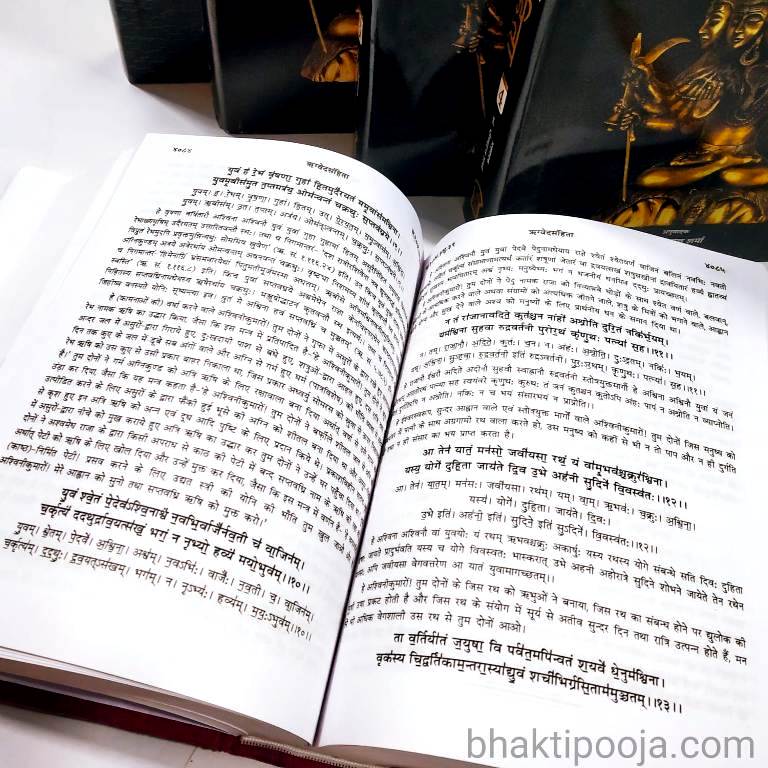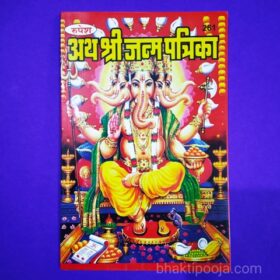Complete Four Veds Samhita (Charo Ved) Rigveda, Samaveda, Yajurveda, Atharvaveda
Price range: ₹1,150.00 through ₹14,350.00
Rgveda Samhitā (Part I to V)
With Shri Sayanacharya’s Bhasya and its Hindi Translation
By Dr. Bhishmadatt Sharma Sahityacharya, M.A., M.Ed., Ph.D. Former Reader, Deptt. of Education, N.A.S. College, Meerut (U.P.)
SAMAVEDASAMHITA Along with SAYANABHASYA
Edited with Hindi Translation By Pt. Ramswaroop Sharma Gaud
ŚRIMAD-VĀJASANEYI-MADHYANDINA SUKLAYAJURVEDA-SAMHITA (Text and Padapāṭha)
With the Mantra-Bhasya of Srimad-Uvaṭācārya & The Vedadīpa-Bhasya of Sriman Mahidhara (With Appendices & Mantra-Koşa)
Edited by Vasudeva Lakṣmaṇa Šāstri Paṇasīkara Along with The ‘Tattvabodhini’ Hindi Commentary by Dr. Ramakrishna Shastri
ATHARVA-VEDA-SAMHITĀ Along with SAYANABHASYA Volume 1 to 8
Edited with Hindi Translation By Pt. Ramswaroop Sharma Gaud
सम्पूर्ण ऋग्वेद संहिता (५ भाग में) , अर्थर्ववेद संहिता ( ८ भाग में) , सामवेद संहिता, यजुर्वेद संहिता संस्कृत तथा हिंदी अनुवाद सहित चौखम्बा , काशी द्वारा प्रकाशित
Rgveda Samhitā
With Shri Sayanacharya’s Bhasya and its Hindi Translation
By Dr. Bhishmadatt Sharma Sahityacharya, M.A., M.Ed., Ph.D. Former Reader, Deptt. of Education, N.A.S. College, Meerut (U.P.)
SAMAVEDASAMHITA Along with SAYANABHASYA
Edited with Hindi Translation By Pt. Ramswaroop Sharma Gaud
ŚRIMAD-VĀJASANEYI-MADHYANDINA
SUKLAYAJURVEDA-SAMHITA
(Text and Padapāṭha)
With the Mantra-Bhasya of Srimad-Uvaṭācārya & The Vedadīpa-Bhasya of Sriman Mahidhara
(With Appendices & Mantra-Koşa)
Edited by Vasudeva Lakṣmaṇa Šāstri Paṇasīkara Along with The ‘Tattvabodhini’ Hindi Commentary by Dr. Ramakrishna Shastri
ATHARVA-VEDA-SAMHITĀ
Along with SAYANABHASYA
Volume 1 to 8
Edited with Hindi Translation By Pt. Ramswaroop Sharma Gaud
The Vedas are the religious texts which inform the religion of Hinduism (also known as Sanatan Dharma meaning “Eternal Order” or “Eternal Path”). The term Veda means “knowledge” in that they are thought to contain the fundamental knowledge relating to the underlying cause of, function of, and personal response to existence.
They are considered among the oldest, if not the oldest, religious works in the world. They are commonly referred to as “scripture”, which is accurate in that they can be defined as holy writ concerning the nature of the Divine. Unlike the scriptures of other religions, however, the Vedas are not thought to have been revealed to a certain person or persons at a specific historical moment; they are believed to have always existed and were apprehended by sages in deep meditative states at some point prior to c. 1500 BCE but precisely when is unknown.
The Vedas existed in oral form and were passed down from master to student for generations until they were committed to writing between c. 1500 – c. 500 BCE (the so-called Vedic Period) in India. They were carefully preserved orally as masters would have students memorize them forwards and backwards with emphasis on exact pronunciation in order to keep what was originally heard intact.
The Vedas are therefore regarded as Shruti in Hinduism meaning “what is heard” as contrasted with other texts designated Smritis (“what is remembered”), accounts of great heroes and their struggles in works such as the Mahabharata, Ramayana, and Bhagavad Gita (although some sects of Hinduism regard the Bhagavad Gita as Shruti). The texts which make up the Four Vedas are:
- Rig Veda
- Sama Veda
- Yajur Veda
- Atharva Veda
Each of these is further divided into types of text included within them:
- Aranyakas – rituals, observances
- Brahmanas – commentaries on said rituals
- Samhitas – benedictions, prayers, mantras
- Upanishads – philosophical narratives and dialogues
The Samhitas (Sanskrit saṃhitā, “collection”), are collections of metric texts (“mantras”). There are four “Vedic” Samhitas: the Rig-Veda, Yajur-Veda, Sama-Veda and Atharva-Veda, most of which are available in several recensions (śākhā). In some contexts, the term Veda is used to refer only to these Samhitas, the collection of mantras. This is the oldest layer of Vedic texts, which were composed between circa 1500–1200 BCE (Rig Veda book 2–9), and 1200–900 BCE for the other Samhitas. The Samhitas contain invocations to deities like Indra and Agni, “to secure their benediction for success in battles or for the welfare of the cln.”
| Weight | 830 g |
|---|---|
| Dimensions | 25 × 19 × 2.6 cm |
| Division | Rig Veda, Sama Veda, Yajur Veda, Atharva Veda, Set of 4 |




























Reviews
There are no reviews yet.